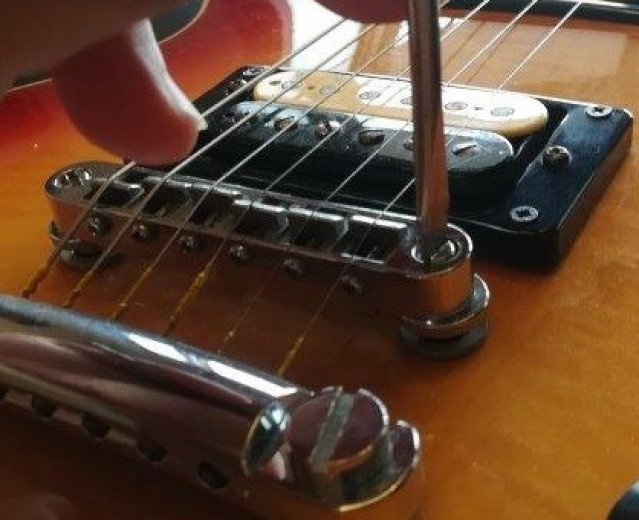In this article you will find
instructions and tips about action adjustment of electric and
acoustic guitars. It is a set of operations that includes the neck truss-rod
adjustment, described on the Soundsation blog in the articles What is the truss-rod? and Let's adjust the truss-rod.
Before continuing you must have:
- a well levelled and finished fretboard
- well installed and
tuned strings
- a correct height nut
- a neck
adjusted according to your taste.
All that verified, we can now
talk about how to adjust the action by yourself acting on the bridge and its
saddles.
What is the action?
Action is a piano derived word by which
is substantially intended the way a guitar player feels the strings under his fingers on the fretboard. The main reference for this more or
less comfortable feeling is the distance between strings and fret tops. It is a
fundamental measure for enjoying a comfortably playing instrument
without compromising the sound, but its adjustment includes at least two
operations, that must be done after the strings have been installed on the
guitar.
- Neck straightness
As you may have read in the blog articles What is the truss-rod? and Let's adjust the truss-rod, electric, steel string acoustic and even some classical nylon string guitar necks are equipped with a truss-rod. The adjustment makes it possible to correct the neck tendency to take a non-straight line with respect to the straight line depicted by the strings between the nut and the bridge, distancing from, or approaching to them around its centre portion. - Bridge and saddle height
The guitar bridge height adjustment allows to approach or move away the strings from the fretboard. Electric guitars can be equipped with bridges with saddles that can be fixed in the vertical direction or individually adjusted in height, adding a further step of setting.
Acoustic
guitars, both metal or nylon stringed, are equipped with a fixed
non-adjustable bridge (with rare exception), on which it is possible to
operate only by physically removing a section until the desired height is
obtained.
Kinds of bridges and saddles
The most
popular bridges are:
- the wrap-around style
- the Tune-O-Matic
style
- the Stratocaster
vibrato style
- the Telecaster 3 or 6
saddle style (hard-tail)
- the acoustic or
hybrid fixed style.
Let’s see them
one by one.
Wrap-around bridges
We can define
this kind of bridge as a simplified version of the set consisting of a Tune-o-matic
style bridge and a fixed tailpiece (with studs or a
trapeze). The wrap-around acts as a bridge and a tailpiece at the same time
and can be machined to pre-compensate string intonation. It is one of the
earliest and simplest bridges made. Only its general height can be adjusted
acting on side studs. The bridge curve with respect to the curvature radius
of the fretboard is pre-set. Some modern models feature separate saddles that are horizontally adjustable for
intonation.
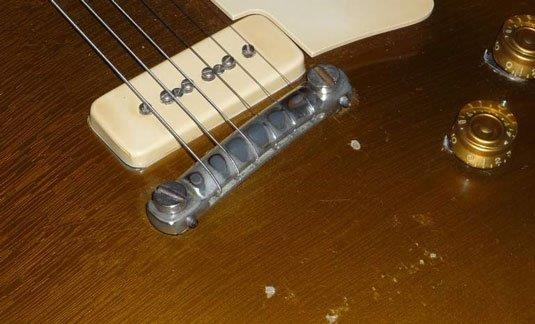
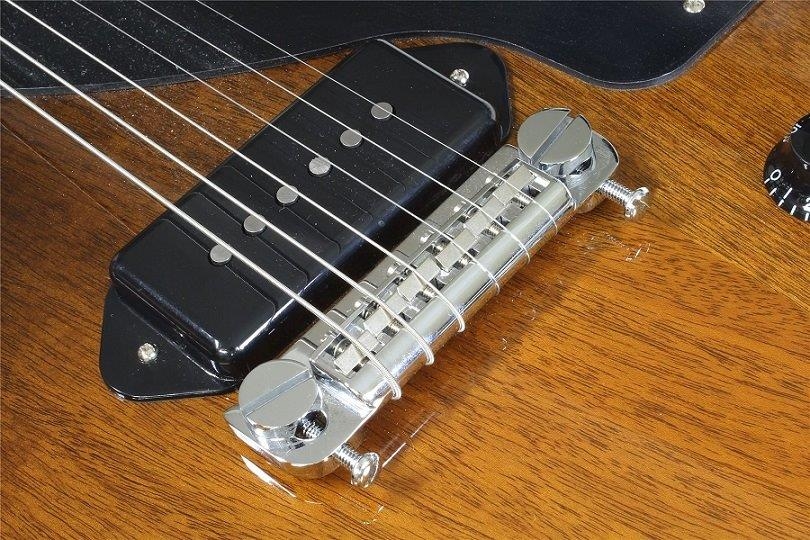
Tune-o-matic style bridges
Whether it is
the ABR-1 Tune-O-Matic (the one with a wire to avoid saddle vibrations) or the successive Nashville
and its versions, from now on we will shortly write TOM. Saddle curvature
radius is non-adjustable and pre-set to follow the fretboard one (usually 12”).
We can only make one adjustment on a TOM bridge: lowering or raising it acting
on side studs. Some models provide the convenient adjustment lock
through tightening.
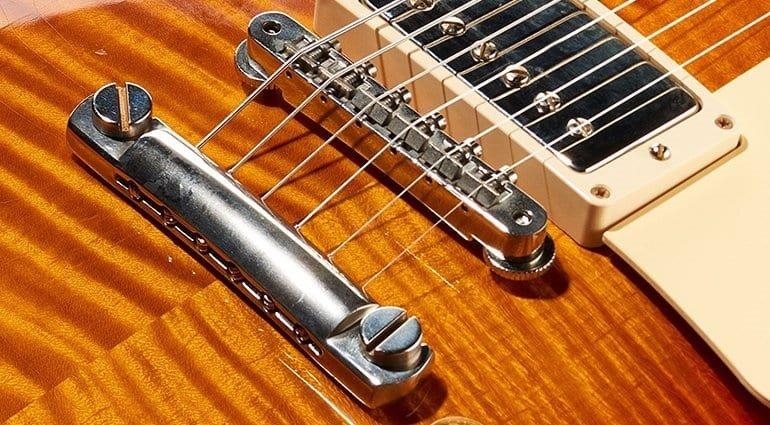
Saddles can be
only horizontally shifted to set intonation; this is a topic we talk about in a
dedicated article on the Soundsation blog. A good luthier can also act on a
single saddle to adjust the height of a single string; but this is a real
master's operation.
Stratocaster style bridges with vibrato
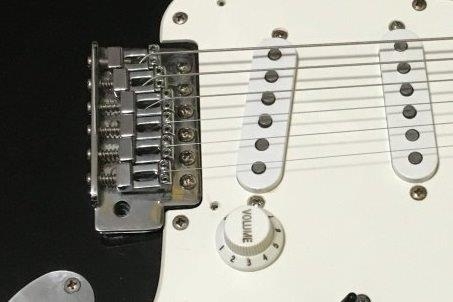
There are a
lot of version of this vibrato bridge (often incorrectly defined tremolo);
to be clear, the one with a bar, also including those floating models with two
mounting studs as the Floyd Rose or Wilkinson style (in the picture) and others, with or without a locking nut or locking tuners.
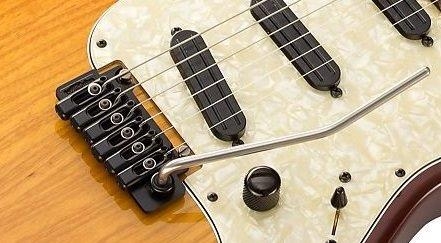
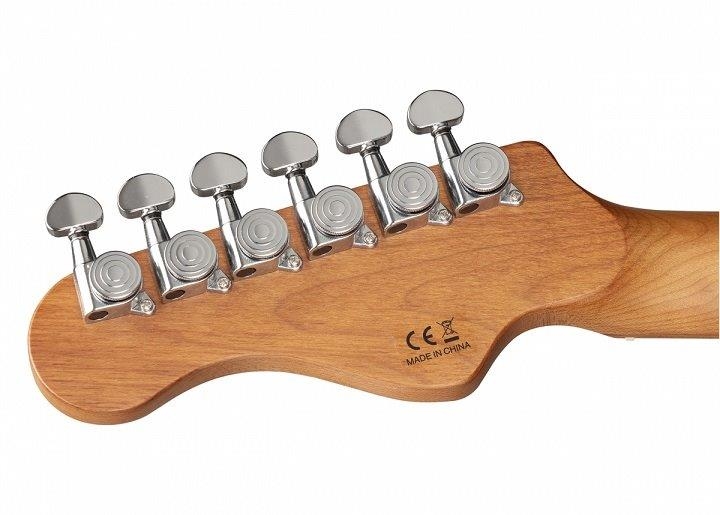
Every vibrato
bridge gives you the possibility of adjusting the saddles both horizontally,
for intonation, and vertically, for string height over the fretboard.
Before
adjusting the saddle height, it is necessary to set the overall height of the bridge
plate, that tilts on two or six screws (less often four) that are inserted in
the guitar body.
The good news
is that in six screw vintage inspired vibrato bridges, the base is practically fixed, while it is possible to tilt the angle
with respect to the body top and get different vibrato performances. So, height adjustment has to be done on every single
saddle, thanks to two Allen head threaded elements.
In most modern
bridges, such as those with a blade plate that swings on two studs
(G&L, Wilkinson, Fender American Standard, Floyd Rose [in the picture]), we
can adjust the general height to some extent, lowering or raising the studs. If
you have to work on two fronts, the plate and the saddles, the adjustment is
more advanced and requires an experienced professional intervention.
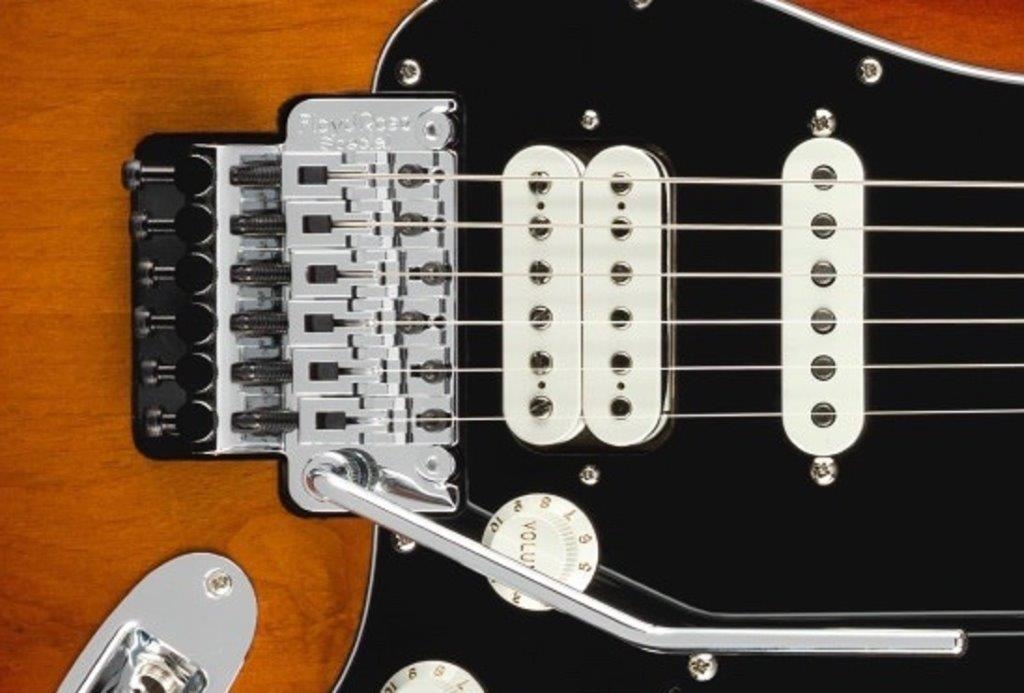
A rare kind of
bridge is the roller or needle bearing vibrato, also a single saddle
height adjustment case.
The complete
setting of a vibrato bridge is the topic of another article on the Soundsation
blog. Here we take for granted that your guitar vibrato is already set
according to your taste.
The Bigsby
vibrato does not need any height adjustment, since it actually is a tailpiece,
always matched with a TOM bridge.
3 or 6 saddle Telecaster style bridges (hard-tail)
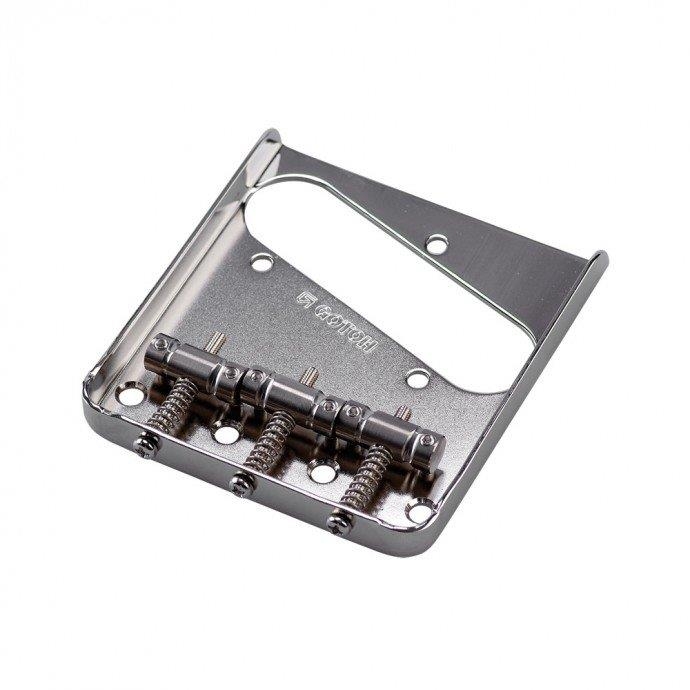
This vintage school fixed bridge is flat mounted on the guitar top and features three saddles, each one
serving a couple of strings; so strings height has to be adjusted by pairs
by means of an Allen wrench, more rarely of a flat screwdriver.
Most modern bridges have six separate saddles and is then possible to adjust any
single string height, such as described about vibrato bridges.
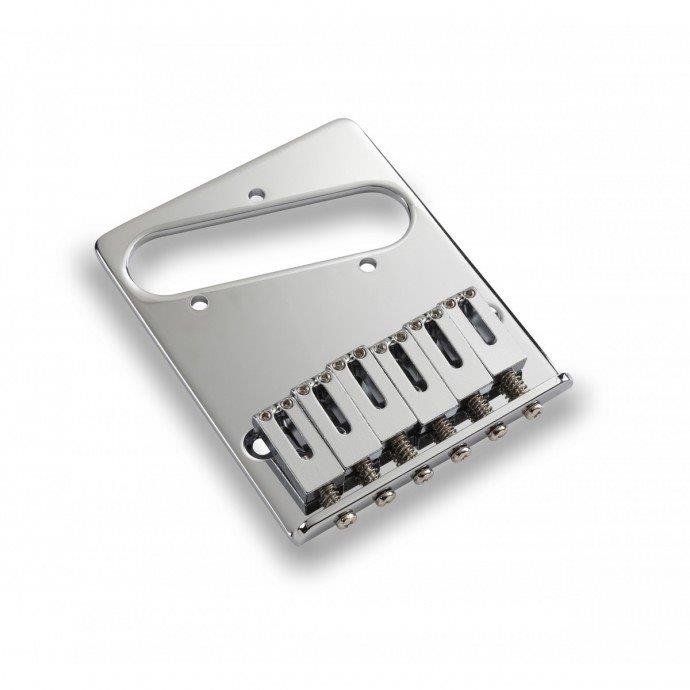
Acoustic, classical and hybrid guitar fixed bridges
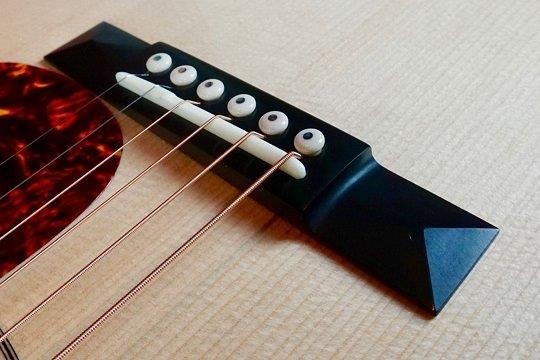
In this case
there is not much to be adjusted because the bridge is made from a single bone
or suitable plastic piece, and includes eventual intonation
pre-setting. If you need to lower the action it is necessary to cut or file the
bone base until the desired height is obtained. If you have to raise the
action, you'd better change the bridge with a higher one.
There are
single string pre-set replacements for classical guitars, that are aimed at improving the general action.
Anyway, working on acoustic guitars is mainly a luthier's and professional repairman's job, mostly when the
instrument is pre-amplified and there is a piezo electric pickup under the bridge; and unless you use solutions as the KNA SG-1 o NG-2 portable piezos!
And now, how are you going to adjust the action?
Sorry to disappoint you, but as far as action specs we are in a
field of great variability. Here are a few proven examples of measured action
from the underside of the first and sixth strings to the 12th fret top: 1
millimetre for Carlos Santana and Jeff Beck; 2 millimetres for Stevie Ray
Vaughan; 3 millimetres for B.B. King.
By example, Fender and Gibson refer for electric guitars to a 1
millimetre relief (we found this word in the articles What is the truss-rod? and Let's adjust the truss-rod), still measured at the 12th fret. These specifications can be improved
by a luthier, who can get even half the value!
Back to the real world, equip yourself with a caliper or some
shims: if you find on your guitar a distance of 1 millimetre between lower E
and the 12th fret, consider yourself lucky and enjoy your
instrument.
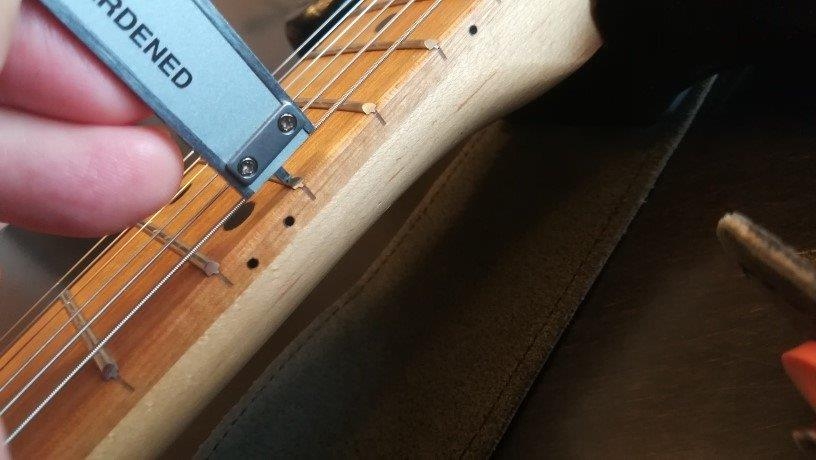
Instead, if you have adjusted the neck straightness and you want a great
action according to your taste, you will need to work with patience on the bridge
studs and saddles. It would be good if the studs were completely screwed
into their holes, but you can raise them a little if needed; simply turn their
slot head with a screwdriver.
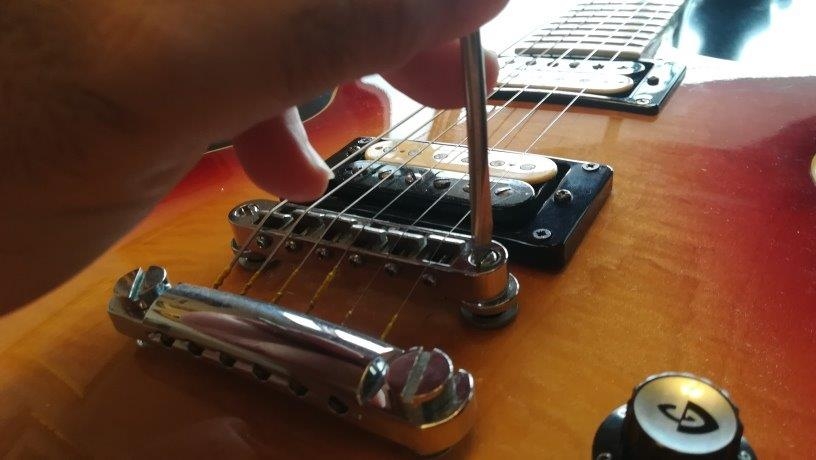
The adjustment can be hard if the instrument is in tune, so it is useful
to loosen the strings before acting on the threaded washers that make the TOM
move vertically. The market offers devices (as the one showed in the photo)
that facilitate washer rotation; but they must have a correct step.
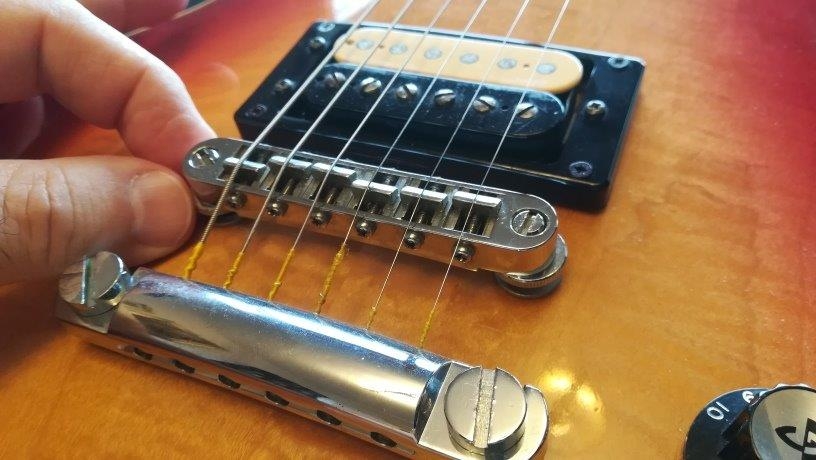
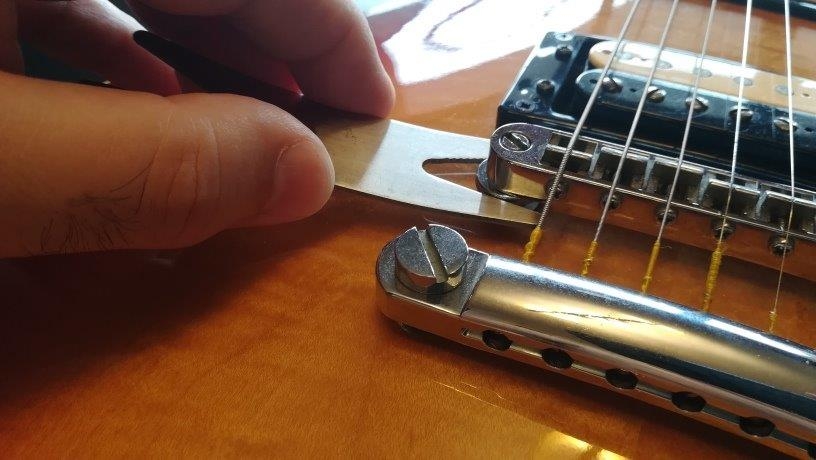
Less trouble for separately adjustable saddles: insert the wrench and
go.
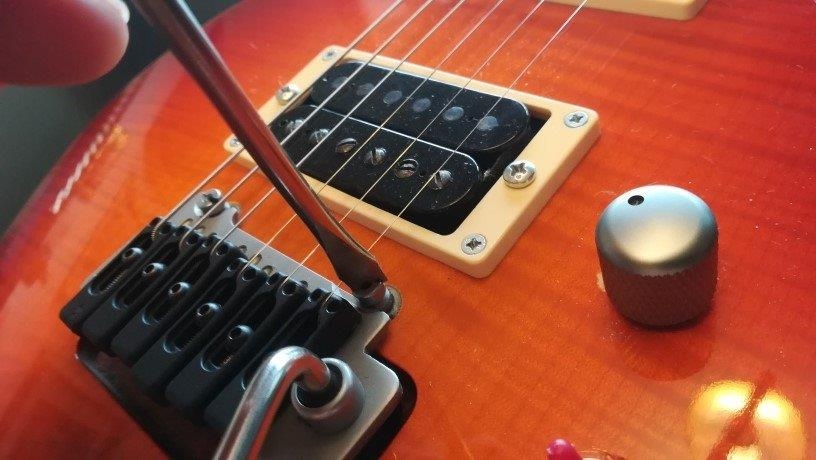
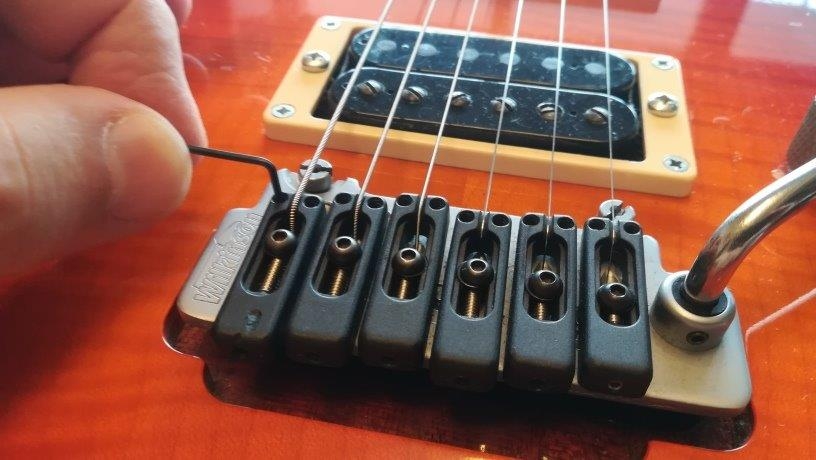
Let's follow the radius
Guitar fretboards can have different curvature radiuses, from the
faithfully vintage and noticeably curved 7” ½ to the popular 9” ½, from 12” to
14” and over, towards an almost flat pattern suitable for fretboard racers.
There also are compound curvature radiuses, in which the
fretboard becomes flatter going closer to the instrument body, thus making
easier barre chords and comping through the first portion of the neck, and
bending and solos through the second one.
As we said, wrap-around and TOM bridges feature a factory pre-set
curvature that traces the fretboard of the instrument on which they are
installed.
Inserire immagine “radius
tom.jpg”
The situation is different for bridges with individually adjustable
saddles, in which it is necessary to arrange them and follow the fretboard
radius.
Start placing the saddles of the two outermost strings at the desired height,
then go on with the other strings in order to get a curve with D and G strings
at the centre top. It is important to know your fretboard radius and rely on
your eyes and experience. Also use gauges and the measuring tools
that can be found on the market.
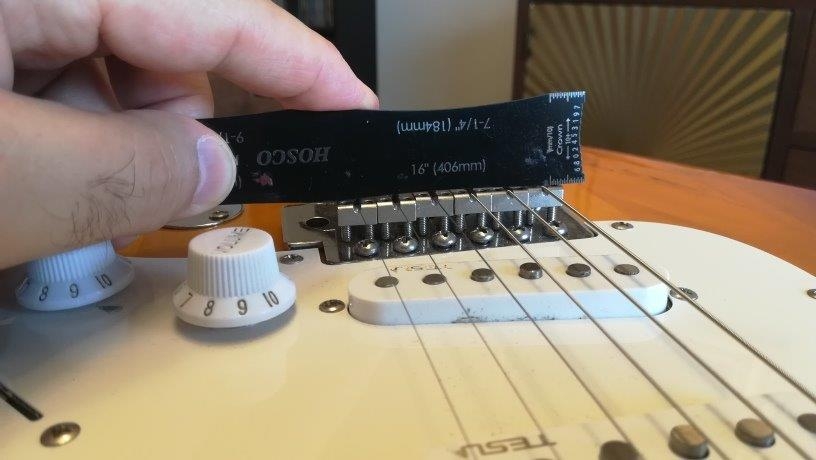
A hint about the stud tailpiece
The Gibson school stud tailpiece height can be adjusted,
especially in relation to the bridge. The string angle between these two
parts has an important influence on general tension and finger feel while
playing. We will talk about it again. For now remember that strings should not
touch the TOM edge leaving it into the tailpiece.
A hint about the nut
As we know, our guitar strings are stretched between two points: the
bridge and the nut. The nut features factory made grooves. However,
sometimes the grooves are not precisely cut, or we simply prefer different
depths from factory standards due to our playing requirements and
pleasantness of fretboard contact.
Though there are useful height adjustable nuts, these are seldom adopted
by manufacturers and usually opposed by guitarists. So, talking about the
classic bone or plastic set nut, its adjustment is a matter for professional
workers, who know how to lower and raise it completely, or just working on
single grooves with shims, files and glue mixed bone dust.
What we humble guitar players can do is to verify that the nut height
makes our playing comfortable and in-tune. If the nut is too low, you will hear the strings buzzing if open or in the first
positions; if the nut is too high, you will experience trouble in playing and
intonation.
It is simple and useful to refer to string height at
the first fret, helping yourself with a business card or something similar. As
a rule of thumb the business card should freely slip under the strings at the
first fret, but it should not slip off too easily. If you are in doubt, ask you
luthier.
Some tips
Once you have set the height of the first and sixth strings and
made the other strings follow the fretboard radius, it is possible to optimize
the saddle curve according to your taste.
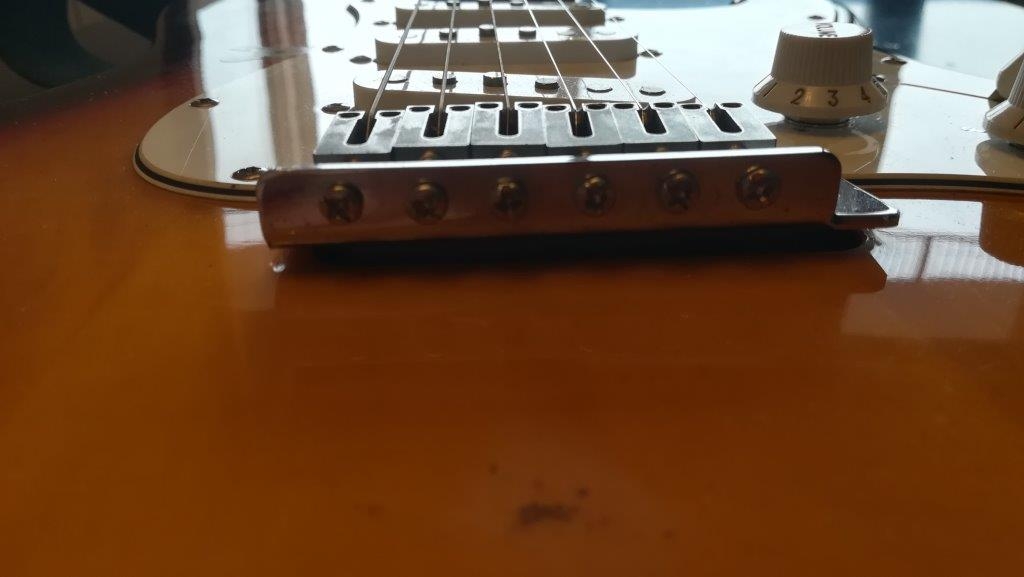
For instance, raise a little the lower strings, particularly the sixth
one, and allow a greater freedom of vibration; or even lower a little
the first and second string to facilitate fingering during solos;
also, raise a little the third string to improve bending on the second
one. Your downward limit will be the beginning of string buzzing, the upward
limit will be your fatigue in performing.
Adjust and try to play, adjust again and play again, and again...
Finally you will get an instrument as you wanted it, with a properly straight
neck and strings set at the desired height for your playing!
It's not over, though... An article on the Soundsation blog will deal
with the crucial adjustment of intonation!
Fabrizio Dadò
